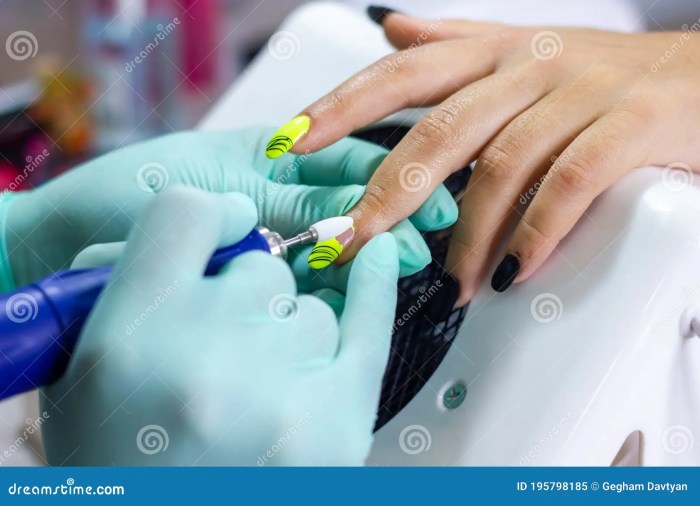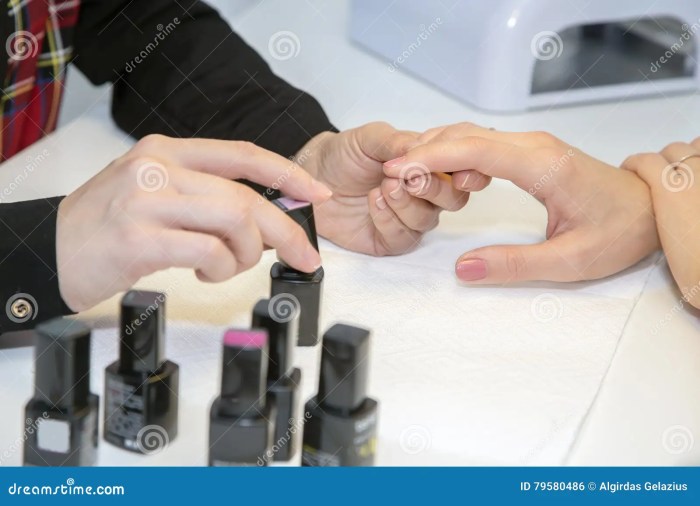Manicurist Nail Polish A Comprehensive Guide
Manicurist Services and Nail Polish Selection
Manicurist nail polish – A skilled manicurist plays a crucial role in selecting the right nail polish to enhance a client’s appearance and nail health. This involves understanding various nail polish types, application techniques, and client preferences.
Factors in Nail Polish Selection
Manicurists consider several factors when choosing nail polish for a client. These include the client’s skin tone, personal style, the occasion, the condition of their nails (e.g., dryness, brittleness), and the desired longevity of the manicure. They also assess the client’s preferences regarding color, finish (matte, glossy, shimmery), and overall aesthetic.
Types of Nail Polish and Suitability
Several nail polish types cater to different needs and nail conditions. Regular nail polish offers a wide range of colors and is easily removed, making it suitable for everyday wear. Gel polish provides longer lasting results, ideal for clients who want a manicure that lasts several weeks. Acrylic nails offer a more robust solution for strengthening weak nails and creating various nail art designs.
Each type has its own pros and cons in terms of application, removal, and longevity.
Choosing the Perfect Nail Polish Shade
Selecting a complementary nail polish shade involves understanding color theory and its relation to skin tone. Generally, warmer skin tones pair well with warmer colors (reds, oranges, browns), while cooler skin tones are enhanced by cooler colors (blues, purples, pinks). The manicurist should also consider the client’s style and the occasion to choose a shade that reflects their personality and the event.
Comparison of Long-Lasting Nail Polish Options
| Type | Application | Removal | Longevity |
|---|---|---|---|
| Gel Polish | Requires UV/LED lamp curing | Requires soaking and filing | 2-3 weeks |
| Acrylic Nails | Applied and shaped by the manicurist | Filed and soaked off | 4-6 weeks |
| Dip Powder | Powder dipped onto prepared nails, sealed with activator | Soaked and filed | 2-3 weeks |
| Shellac | Similar to gel, but less damaging | Soaked off | 2 weeks |
Nail Polish Application Techniques: Manicurist Nail Polish

Source: dreamstime.com
Proper nail polish application is key to achieving a professional and long-lasting manicure. This involves careful preparation of the nails, precise application of the polish, and the use of appropriate tools.
Proper Nail Polish Application Steps, Manicurist nail polish
The process typically involves these steps: cleaning and shaping the nails, applying a base coat to protect the nail bed and enhance polish adhesion, applying two thin coats of color polish, allowing each coat to dry completely, and finishing with a top coat for shine and durability.
Tips for a Smooth, Even Finish
To achieve a flawless finish, avoid thick coats of polish, use smooth, controlled strokes, and let each coat dry thoroughly before applying the next. Using a high-quality brush can significantly improve the application process.
Importance of Nail Preparation
Proper nail preparation is crucial for achieving a long-lasting manicure. This includes gently pushing back or trimming cuticles, shaping the nails, and thoroughly cleaning the nail plate to remove any oils or debris. This ensures optimal adhesion of the nail polish.
Comparison of Different Brush Types
Different brush types influence the final result. Flat brushes are excellent for achieving a smooth, even coat, while angled brushes are ideal for creating precise lines and intricate designs. The quality of the brush also affects the application; a high-quality brush will typically provide smoother and more even results.
Nail Art and Polish Design
Nail art allows for creative expression and personalization of manicures. A wide range of techniques and designs can be incorporated using various nail polish colors and tools.
Popular Nail Art Designs
- French Manicure
- Ombre Nails
- Geometric Designs
- Floral Designs
- Animal Prints
- Abstract Art
Creating an Ombre Nail Design
An ombre effect is achieved by blending two or more shades of nail polish together, creating a gradual transition between colors. This can be done using a sponge or a small brush, carefully blending the colors on the nail.
Applying Nail Polish Stencils
Nail polish stencils provide a simple way to create intricate patterns. These are applied to the nail before applying the polish, creating clean lines and precise designs. Once the polish is dry, the stencil is carefully removed to reveal the pattern.
Nail Art for Various Occasions
- Weddings: Elegant designs with subtle colors and embellishments.
- Parties: Bold colors, glitter, and eye-catching designs.
- Everyday Wear: Simple, neutral colors, or subtle accents.
Nail Polish Trends and Popular Brands
The nail polish industry is constantly evolving, with new trends and popular brands emerging regularly. Understanding these trends and brands is essential for a manicurist to offer up-to-date and desirable services.
Current Trends in Nail Polish
Current trends often reflect seasonal changes and fashion influences. Popular trends include metallic finishes, pastel shades, bold jewel tones, and minimalist designs. The specific trends change frequently, so staying updated through industry publications and social media is important.
Popular Nail Polish Brands
Several brands are known for their quality, range of colors, and innovative formulas. These brands often have unique selling points, such as long-lasting formulas, vegan options, or cruelty-free practices. Examples include OPI, Essie, CND, and Gelish.
Chemical Composition of Nail Polish
Regular nail polish typically contains solvents, resins, pigments, and plasticizers. Gel polish contains similar components but also includes oligomers and photoinitiators that cure under UV/LED light. Acrylic nails use a liquid monomer and a powder polymer that combine to form a hard, durable surface.
Comparison of Nail Polish Brands

Source: dreamstime.com
| Brand | Price Point | Quality | Unique Selling Point |
|---|---|---|---|
| OPI | Mid-range to High | High | Wide color selection, long-lasting formulas |
| Essie | Mid-range | High | Classic colors, easy application |
| CND Shellac | High | High | Long-lasting gel polish, less damaging than traditional gel |
| Gelish | High | High | Wide range of gel colors and finishes |
Nail Care and Maintenance with Nail Polish
Maintaining healthy nails while using nail polish requires proper care and maintenance. This includes safe removal techniques and preventative measures to avoid common nail problems.
Importance of Proper Nail Care
Proper nail care involves keeping nails clean and hydrated, avoiding harsh chemicals, and using gentle nail polish removers. This helps prevent dryness, brittleness, and other nail problems often associated with frequent nail polish use.
Safe Nail Polish Removal
Safe removal involves using a gentle nail polish remover that is acetone-free or low in acetone. Soaking cotton pads in remover and gently pressing them onto the nails for a few minutes before gently wiping off the polish helps prevent damage to the nails.
Preventing Nail Problems
To prevent common problems like dryness and brittleness, regular moisturizing is essential. Using a cuticle oil and a nourishing hand cream can help keep nails and the surrounding skin hydrated. Avoiding excessive filing and harsh chemicals is also crucial.
Impact of Nail Polish Removers
Acetone-based removers are more effective but can be drying and potentially damaging to the nails if used excessively. Acetone-free removers are gentler but may require longer soaking times. Choosing a remover that suits the nail type and frequency of polish use is essential.
Manicurist’s Business and Marketing
Building a successful manicure business requires effective marketing strategies and efficient inventory management. Understanding client needs and preferences is key to attracting and retaining clientele.
Marketing Nail Polish Services
Marketing strategies can include social media presence, online booking systems, collaborations with local businesses, and offering promotions and loyalty programs. High-quality photos and videos showcasing nail art and services are crucial for attracting clients.
Building a Strong Client Base
Building a strong client base involves providing excellent customer service, offering a wide range of services, and maintaining consistent quality. Encouraging client reviews and referrals can also help expand the business.
Managing Nail Polish Inventory
Efficient inventory management involves tracking stock levels, regularly ordering popular colors, and minimizing waste. Using a point-of-sale system can help manage inventory and sales effectively.
Marketing Campaign for Unique Services
A marketing campaign could highlight a unique selling proposition, such as specializing in a particular nail art style, offering organic or vegan nail products, or providing personalized manicure experiences. The campaign should emphasize the benefits and uniqueness of these services.
FAQ Compilation
What is the difference between gel and regular nail polish?
Gel polish requires a UV or LED lamp to cure and lasts significantly longer than regular polish, typically two to three weeks. Regular polish is easier to remove but chips more quickly.
How can I prevent nail polish from chipping?
Proper nail preparation is key. Ensure nails are clean, dry, and free of oils before applying polish. Use a base coat, apply thin coats of color, and finish with a top coat. Avoid harsh chemicals and moisturize your cuticles regularly.
How often should I change my nail polish?
Ideally, change your nail polish every 7-10 days, or sooner if it begins to chip or show signs of wear. This helps prevent the buildup of bacteria and keeps your nails looking their best.
What should I do if my nails are brittle or weak?
Limit exposure to harsh chemicals, moisturize regularly, and consider using nail strengtheners. Avoid using overly aggressive nail polish removers and take breaks from polish application to allow your nails to recover.
















